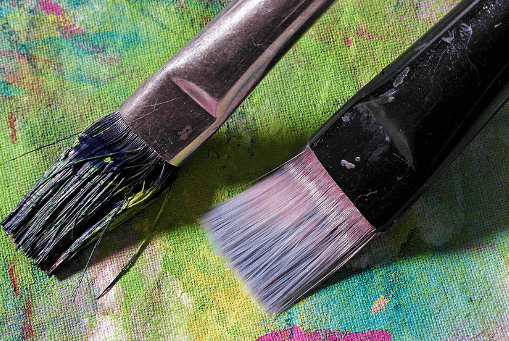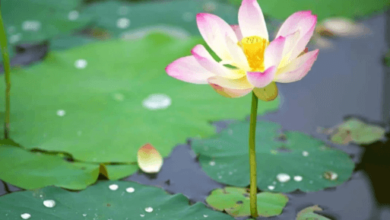How To Clean Acrylic Painting

Creating acrylic paintings is not easy. It’s time-consuming and takes a lot of patience and skills. Acrylic paint as a medium is beautiful and becoming more and more popular. However, the downside of water-based acrylic paints is they attract dust and dirt. Then, hold them in place making dirt and dust difficult to remove even when the acrylic painting is dry. As time passes by, the accumulated dirt and dust will damage the painting’s integrity and look. That’s why it’s important to seal, clean, and store them properly.
Before you start storing or cleaning your artwork, don’t forget to seal them carefully. Once they’re properly sealed, cleaning and maintenance are a lot easier.
There are two ways to clean acrylic painting to extend its beauty, quality, and integrity, here’s how.
Removing Dust From An Acrylic Painting
Before you start dusting your acrylic painting, it’s necessary to ensure the paint is dry before you touch it or anything comes in contact with it. If it’s still wet, the acrylic paint will smudge and some important features and brush strokes can become dull. Once the acrylic paint has fully cured and dried out, you can brush off any dirt and debris and then seal the painting to protect its integrity and look. It might take at least 24 hours before the paint is fully cured and dried.
To remove the dust and dirt on your acrylic portrait painting, you will need a soft-bristled brush with a wide base and fine bristles. Look for a brush made from natural hair. It is perfect for removing fine, loose debris and dirt lightly stuck in your painting. You can also use a hand duster or makeup brush. Always make sure your brush is clean and dry before it comes in contact with your acrylic painting to avoid adding more unwanted debris.
Here’s how to brush off debris and dirt from the acrylic painting:
Carefully brush over the exterior of the painting. Use long fluid strokes.
Start from the upper corner across the acrylic painting and down.
Don’t put too much force and pressure when brushing or it will leave behind marks on your painting.
Clean the frame or other surfaces around the acrylic painting.
If your painting is exposed and unframed, dust it regularly, about every couple of months to avoid buildup.
Cleaning Acrylic Painting With Soap And Water
If you’ll use the water and soap method, be aware of the possible risks of this cleaning method. Cleaning materials, especially DIYs, can be harmful to acrylic paint and other mediums. Some ingredients can lead to discoloration or dulling of acrylic paint leading to decreasing its value, quality, and beauty. Acrylic paint might be less temperamental than other types of paint. However, it can still be damaged or ruined if it comes in contact with harmful and inappropriate materials. Never use abrasive materials and harsh chemicals when cleaning your acrylic painting.
If you’re unsure if you can clean your acrylic painting by yourself, it’s best to contact professional cleaners to avoid damaging your precious painting. This is essential, especially if you’re an art collector with valuable pieces of art.
To clean the acrylic painting using the soap and water method, you need non-astringent liquid dish soap, warm water, a bucket, and a clean soft microfiber cloth. Here are the steps:
Fill the bucket with clean, warm water.
Add a few drops of non-astringent dish soap to the bucket.
Stir well until it’s mixed well and you get a solution.
Get your clean, dry microfiber cloth and dampen it in the solution.
Squeeze out excess solution and remove as much solution as possible. There shouldn’t be any heavy soap residue on the cloth. Also, some acrylic paint is water soluble. If there’s a lot of moisture in your cloth, it will dissolve the paint.
Try the moistened cloth on an unscrupulous or hidden part of the painting to see how the paint reacts to the solution. If there are no damages or negative effects to the painting, you can proceed to the next step.
Carefully wipe the painting with a slightly damp cloth.
Use uniform long, smooth strokes when wiping. Start from the bottom, up. Don’t apply too much pressure and force to prevent stripping the paint off.
Let the surface of the painting dry before wiping it again. Fold the cloth and use other parts to avoid drying the painting too much. This will help distribute the moisture evenly to avoid smudges and damage to the acrylic painting.
Takeaway
Acrylic paintings are hard to make and can be expensive. If you’re an art collector, you must understand how important care and maintenance are to your art pieces. This includes proper storage, care, and maintenance, including removing dirt and debris stuck into the acrylic painting.
And for artists, knowing these few cleaning tricks are essential to protect the integrity, quality, and look of your acrylic painting. It also helps improve your reputation as an artist. Remember, accumulated dust and debris can damage your painting. By sealing and ensuring your acrylic painting is clean and dust-free, your reputation will greatly improve and sell more artwork.




